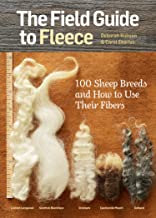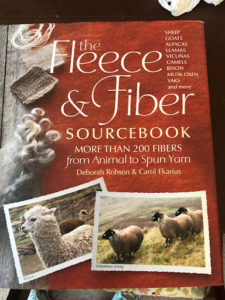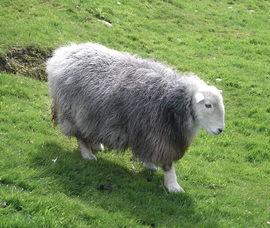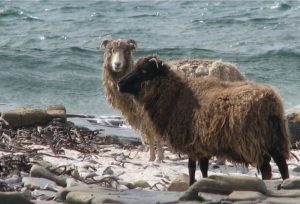A Conversation with Deborah Robson
Cathy M Koos
Recently, I had the privilege of Zooming with textile educator and author Deborah Robson. I joined her in her studio in Colorado’s Front Range for a broad-ranging chat. Having just read her Fleece and Fiber Sourcebook (F&F), I had lots of burning questions for her.


The Books
Along with co-author Carol Ekarius, Deb researched and wrote the seminal Fleece and Fiber Sourcebook: More Than 200 Fibers from Animals to Spun Yarn in 2011, followed by the companion Field Guide to Fleece: 100 Sheep Breeds and How to Use Their Fiber in 2013. These two timeless volumes quickly became not only thorough reference guides but beautiful coffee table books as well.
Deb’s interest in various breeds of sheep and qualities of wool came to her early on during a stint in the mid-80s when she was an editor at Shuttle, Spindle and Dyepot. Deb is incredibly involved in studying natural fibers and the wide variety of sheep’s wools and making textiles.
When I asked how Deb and Carol arrived at “200 breeds,” Deb said they gave themselves six months to select and organize the book through breed and conservation societies and word-of-mouth. For instance, the Valais Blackface was not included in the book because growers would need to know French or German in order to easily communicate with the breeders.
The subsequent fleece sources came from eBay, individual shepherds and that same word-of-mouth.
During those six months, they organized the raw fleece, washed the samples, spun the yarn and developed the sheep biographies. Knitters then made standard swatches and weavers made standardized woven samples using a Weave-It loom.
After eleven days of studio photography at Storey Publishing followed by draft reviews, the final publication was complete. Wow!
What is the Rare Breed Backstory?
Deb shared that rare livestock breed awareness and conservation began in the United Kingdom in 1973 with the Rare Breeds Survival Trust (RBST). Its sister organization in the US came a few years later, first as the American Minor Breeds Conservancy (AMBC), and later renamed The Livestock Conservancy. Both organizations focus on preserving the genetic resources of heritage livestock. Since its inception in 1973, no UK-native breed has become extinct. Considering that the entire island of Great Britain has the same square miles as Minnesota, and the fact that more than 60 breeds of sheep exist in such a relatively small geolocation is astonishing.
Why preserve these old breeds? Like heritage seed sources, heritage breeds have evolved to suit a particular landscape, climate, or purpose. Sheep and cattle in the UK have adapted to harsh weather and marginal forage. Take, for instance, the Herdwick sheep of the rainy Lake District of England. Their coats “resemble the mottled gray of the local granite boulders and shed rain remarkably well.” (F&F, page 266)

(Herdwick sheep, Wikipedia)
The ancient North Ronaldsay sheep of the Orkney Islands is an example of flourishing on marginal forage – in this case, seaweed. (F&F, page 174). A recent study by UC Davis has found that feeding cattle a small amount of seaweed can reduce emissions by up to 82% https://www.ucdavis.edu/news/feeding-cattle-seaweed-reduces-their-greenhouse-gas-emissions-82-percent , so you can see where this trend is going.

By Ian Caldwell – Own work, CC BY 2.5, https://commons.wikimedia.org/w/index.php?curid=1741542
The charming, multi-horned Jacob sheep has another unusual story. In addition to their lovely fleece, one particular breeding line in Texas is helping scientists research Tay-Sachs disease, a lysosomal hereditary disorder found in humans.
[Point of fact, the AMBC’s mission statement says: “Many of America’s once-common farm animals face extinction if we do not take action now. Rare farm animals represent an irreplaceable piece of earth’s biodiversity and offer incredible variety that may be needed for future farms – robust health, mothering instincts, foraging, and the ability to thrive in a changing climate. These farm animals are a vital part of ensuring food security for our planet – now and for the future.”]
Disease and Other Tragedies
I asked Deb about the 1987 and 2001 outbreaks of Hoof and Mouth disease (HMD) in the UK. I remember coming home from visiting family in England and having to go through the shoe cleaning room at the San Francisco airport. Deb related that those outbreaks also contributed to herd loss. HMD is a highly contagious viral disease of cloven-hoofed animals like sheep and cattle. Thousands of animals were culled preemptively, decimating whole flocks, even if not infected. Now, farmers with closed flocks can apply for consideration if another outbreak occurs.
When asked how breeds are considered for critical conservation, Deb shared that it often depends on the designating organization. In the US, new annual numbers are compared to global populations of a breed. The UK looks at population numbers and potential for inbreeding. Many other factors are also considered.
Feral or domesticated? What is the difference?
Deb clarifiedd that feral sheep breeds are domesticated but live with minimal human intervention. Consider the livestock the Spanish and French explorers brought to the Americas. Many sheep breeds like the Churro, Santa Cruz, and Florida Cracker went feral and survived on their own quite well. Some breeds even developed the trait of shedding, thus preventing overheating of wool-bound sheep.
As our climate changes, this very adaptability may become a key to providing food and clothing to the planet. Addressing the survival adaptations of ancient livestock may help us, as well. Kudos to Deb and her colleagues for recognizing and researching this vital aspect of animal husbandry.